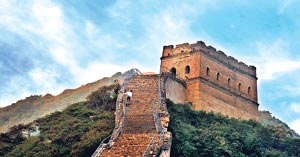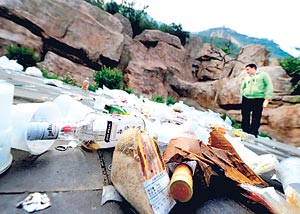BADALING, China, (AFP) - Empty gin and whisky bottles, crumpled beer cans and tattered food boxes are piled up after a rave in China -- perhaps not so unusual, except that the garbage is on the fabled Great Wall.
The filthy remains of the full-moon techno party, which drew several hundred foreigners to one of the sections of the wall at Badaling, about 60 kilometres (35 miles) from Beijing, left Colombian tourist Francisco Garcia in a sad mood.
"It's very bad for the environment," Garcia told AFP, summing up a major problem facing Chinese authorities -- how to preserve the UNESCO World Heritage site while allowing visitors to take advantage of its majestic beauty.
 |
 |
| A lone hiker climbs stairs leading to a watchtower at a remote section of the Great Wall at Badaling, north of Beijing and a garbage heap collected from Badaling. AFP |
The sun rises, gently illuminating the impressive structure snaking over the hills. In a lookout tower, nine brightly-coloured tents have been set up for intrepid campers who spent the night in the early autumn chill.
"We've found nails in the Wall between the stones, put there by campers for their tents," said Wang Xuenong, a former curator of the Shanhaiguan section of the wall, and a lecturer at Beijing's prestigious Tsinghua University.
But he added: "There is no clear ban on sleeping on the wall."William Lindesay, a Briton who has spent nearly a quarter-century working on wall conservation, says he thinks camping at a World Heritage site is simply "unacceptable".
"People are relieving themselves all over it. In the past few months, I have come across big camping groups, pitching 10 or 15 tents and leaving their garbage from dinner and breakfast the following morning," Lindesay told AFP.
Parts of the wall -- which welcomes 10 million visitors a year -- are covered with graffiti, with names and phrases scrawled in English and French.
At Badaling, one of the most popular sections of the wall due to its proximity to the Chinese capital, "you have to walk several kilometres before you can find a brick that has not been carved into," Lindesay said.
The Englishman -- awarded one of Britain's highest honours for his conservation work -- says he fell in love with the Great Wall in 1987, at a time when China was still mainly closed to foreigners.
"I trekked 2,500 kilometres along the remains of the wall -- 78 days of travel, with great difficulty, nine arrests and one deportation!" he recalled.
"For me, it was a turning point. I discovered that the wall is an amazing thing... it is not only a building, it is a landscape," said the 53-year-old Lindesay, who was made an Officer of the Order of the British Empire (OBE).
Since 1998, he has taken groups of volunteers from his association, the International Friends of the Great Wall, to help remove hundreds of kilogrammes (pounds) of garbage from the structure.
He then showed his photos of the destruction to the Beijing Municipal Administration of Cultural Heritage -- to give them what he called a "wake-up call".
"The garbage was just the tip of the iceberg -- it was just highlighting that the Great Wall, an icon of China, a World Heritage site, was suffering from great neglect," Lindesay said.
At Badaling, soaring tourism has led to an explosion in souvenir stalls, food counters and parking lots which detract from the beauty of the site. Elsewhere, factories have been built at the base of the wall.
The structure has been used for all sorts of events -- from motorcycle jumping to catwalk shows -- and as a backdrop for numerous television and film productions.
The wall, which runs through 11 provinces for a total of more than 8,800 kilometres, is not continuous but a series of sections built from the third century BC to the Ming Dynasty (1368-1644).
"It's impossible to manage, there are too many provinces! There is no one department for the protection of the Great Wall," Wang noted. Well before campers and ravers hit the wall, the structure suffered irreparable damage -- first, pathways were cut through it for farmers, then came roads and railways. Local residents have stolen many a stone from it.
"Locals have built entire houses with stones from the wall," Wang said.
More than a quarter of the wall has disappeared for good, and most of what remains is "very broken down", according to Lindesay.
"Only 550 kilometres are in very good condition -- that is, the wall has a structure, with towers still intact," he said. |



